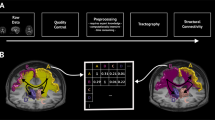Abstract
Diffusion-weighted magnetic resonance imaging (DWI) is the use of specific MRI sequences, which uses the diffusion of Hydrogen atoms to generate contrast and it allows the mapping of the diffusion process of molecules in vivo and reflects interactions with macromolecules, fibers, and membranes among other. Hydrogen atom diffusion patterns (quantification of anisotropy) can reveal microscopic details about tissue architecture, either normal or in a diseased state. A special kind of DWI, diffusion tensor imaging (DTI), has been used extensively to map white matter tractography in the brain. Tractography is a procedure that is used to highlight neural tracts (axon), its fibers position estimation in brain areas has broad potential implications in cognitive neuroscience fields. An algorithm based on diffusion tensor Image is developed and implemented in order to evaluate brain connectivity in different regions of interest. The major objective of this work is represent two-dimensional and three-dimensional connectivity between areas thereby show the potential of the DTI. Results shows how Connectivity Matrix provides statistical data on the pattern of anatomical relationships, this connectivity pattern is formed by synapses that represent the cross correlations and the flow of information.









Similar content being viewed by others
References
Blumenfeld H. Areas of the CNS made up mainly of myelinated axons are called white matter, de Neuroanatomy through clinical cases (2nd ed.), Sunderland, Sinauer Associates Inc, 2010, p. 21.
R. D. Fields, «White Matter Matters,» Sci Am, vol. 1, n° 298, pp. 54 - 61 , 2008.
S. Farquharson, «White matter fiber tractography: why we need to move beyond DTI,» J Neurosurg, vol. 118, n° 6, pp. 1367-1377, 2013.
D. K. Jones, «White matter integrity, fiber count, and other fallacies: the do's and don'ts of diffusion MRI,» Neuroimage, vol. 1, n° 73, pp. 239-254, 2013.
L. Penke, «Brain white matter tract integrity as a neural foundation for general intelligence,» Mol Psychiatry, vol. 17, n° 10, p. 1026, 2012.
Duque A, «Anatomía de la sustancia blanca mediante tractografía por tensor de difusión,» Radiología, vol. 50, n° 2, pp. 99-111, 2008.
M. F. Glasser, «DTI tractography of the human brain's language pathways,» Cereb Cortex, vol. 18, n° 11, pp. 2471-2482, 2008.
M. Catani, «A diffusion tensor imaging tractography atlas for virtual in vivo dissections,» Cortex, vol. 44, n° 8, pp. 1105-1132., 2008.
P. Mukherjee , «Diffusion Tensor MR Imaging and Fiber Tractography: Theoretic Underpinnings,» AJNR Am J Neuroradiol, vol. 29, n° 1, pp. 632-641, 2008.
G. Kocevar, «Brain structural connectivity correlates with fluid intelligence in children: A DTI graph analysis,» Intelligence, vol. 72, n° 1, pp. 67-75, 2019.
F. Roman, «Enhanced structural connectivity within a brain sub-network supporting working memory and engagement processes after cognitive training,» Neurobiol Learn Mem, vol. 141, n° 1, pp. 33-43, 2017.
M. Ingalhalikar, «Sex differences in the structural connectome of the human brain,» Proc Natl Acad Sci, vol. 111, n° 2, pp. 823-828, 2014.
P. Hagmann, «Understanding diffusion MR imaging techniques: from scalar diffusion-weighted imaging to diffusion tensor imaging and beyond,» Radiographics, vol. 26, n° 1, pp. 205-223, 2006.
R. D. Rafal, «Connectivity between the superior colliculus and the amygdala in humans and macaque monkeys: virtual dissection with probabilistic DTI tractography,» J Neurophysiol, vol. 114, n° 3, pp. 1947-1962, 2015.
Verly M. Microstructural organization of the language connectome in typically developing left-handed children: a DTI tractography study, de ISMRM, Singapore, 2016.
N. D. Institute, Neurofunctional Imaging, Université de Bordeaux, Group (GIN-IMN), [En línea]. Available: http://www.gin.cnrs.fr/en/tools/aal-aal2/. [Último acceso: 01 01 2019].
N. Tzourio-Mazoyer, «Automated Anatomical Labeling of Activations in SPM Using a Macroscopic Anatomical Parcellation of the MNI MRI Single-Subject Brain,» NeuroImage, vol. 15, n° 1, pp. 273-289, 2002.
Author information
Authors and Affiliations
Corresponding author
Ethics declarations
Conflict of Interest
The authors declare that they have no conflict of interest.
Ethical approval
This paper does not contain any studies with human participants or animals performed by any of the authors.
Additional information
Publisher’s note
Springer Nature remains neutral with regard to jurisdictional claims in published maps and institutional affiliations.
Rights and permissions
About this article
Cite this article
Hernandez, N.R., Montelongo, R.H., Bernal, J.M.C. et al. Development and implementation of algorithms with diffusion tensor images to evaluate brain connectivity. Health Technol. 10, 471–478 (2020). https://doi.org/10.1007/s12553-019-00376-7
Received:
Accepted:
Published:
Issue Date:
DOI: https://doi.org/10.1007/s12553-019-00376-7




